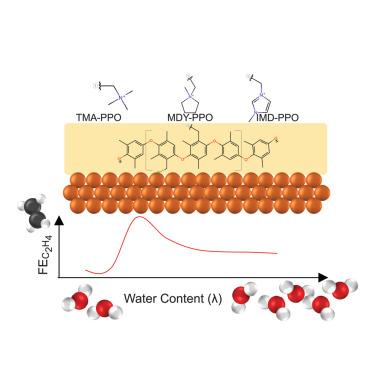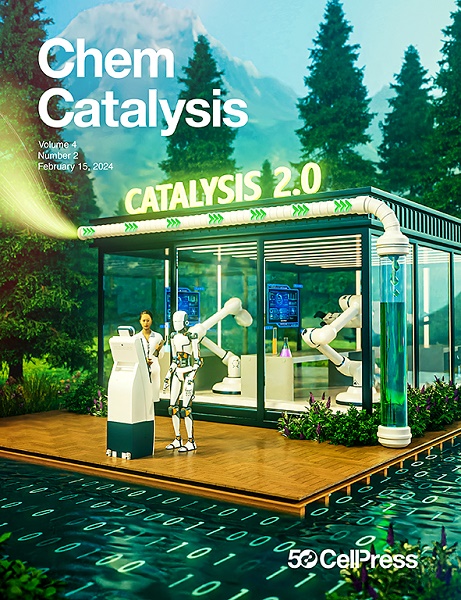设计离子单体以控制二氧化碳电解低压乙烯生产的含水量
IF 11.6
Q1 CHEMISTRY, PHYSICAL
引用次数: 0
摘要
电化学二氧化碳还原(eCO2R)通过生产有价值的商品,如乙烯,为工业部门脱碳提供了希望。在铜基eCO2R阴极上加入聚合物电解质离聚体对于提高eCO2R效率至关重要。这些离聚体控制着阴极的质量传递、表面化学和吸水,从而实现了对所需C2产物的选择性调整。界面性质的复杂性和相互依赖性导致了该领域定义催化剂层离聚体的设计性质的挑战,这些离聚体可以提高cu基催化剂的性能。在此,我们系统地研究了离聚体的性质及其与电化学性能的关系,并证明了在200 mA cm - 2下乙烯选择性的能量效率为14.3%。通过多物理场模拟,我们阐明了离聚体含水量的作用是减轻泛洪和控制催化剂表面局部水浓度。从这项研究中获得的知识将促进为eCO2R量身定制的离聚体的合成。本文章由计算机程序翻译,如有差异,请以英文原文为准。

Designing ionomers to control water content for low-voltage ethylene production from CO2 electrolysis
Electrochemical CO2 reduction (eCO2R) holds promise for decarbonizing industrial sectors by producing valuable commodities, such as ethylene. Incorporating polymer electrolyte ionomers onto Cu-based eCO2R cathodes is crucial for enhancing eCO2R efficiency. These ionomers control mass transport, surface chemistry, and water uptake at the cathode, enabling selectivity tuning toward desired C2 products. Complexities and interdependence of interfacial properties have led to challenges within the field to define design properties of catalyst layer ionomers that can enhance the performance of Cu-based catalysts. Herein, we present a systematic investigation into ionomer properties and their relationship to electrochemical performance and demonstrate a 14.3% energy efficiency for ethylene selectivity at 200 mA cm−2. Through multiphysics modeling, we elucidated that the role of the water content of the ionomer is to mitigate flooding and control the local water concentration at the catalyst surface. Translating knowledge from this study will stimulate the synthesis of ionomers tailored for eCO2R.
求助全文
通过发布文献求助,成功后即可免费获取论文全文。
去求助
来源期刊
CiteScore
10.50
自引率
6.40%
发文量
0
期刊介绍:
Chem Catalysis is a monthly journal that publishes innovative research on fundamental and applied catalysis, providing a platform for researchers across chemistry, chemical engineering, and related fields. It serves as a premier resource for scientists and engineers in academia and industry, covering heterogeneous, homogeneous, and biocatalysis. Emphasizing transformative methods and technologies, the journal aims to advance understanding, introduce novel catalysts, and connect fundamental insights to real-world applications for societal benefit.

 求助内容:
求助内容: 应助结果提醒方式:
应助结果提醒方式:


